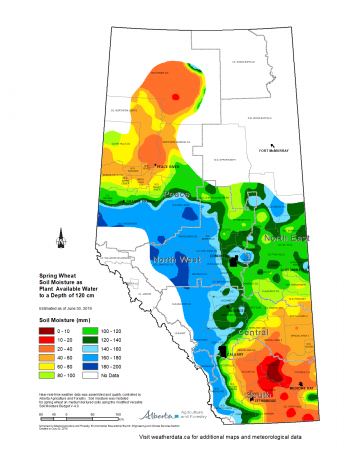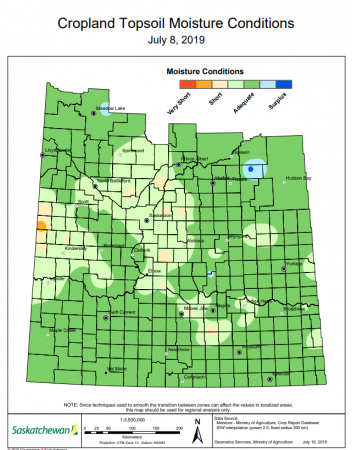
News
Agronomy
Recent moisture improves crop progress across the Prairies
Highlights from the latest crop reports from Alberta, Saskatchewan and Manitoba.
July 10, 2019 By Top Crop Manager
After a hot dry start to the growing season for most of the Prairies, recent rainfall provided some relief for crops. However, for some regions in the Prairies, more moisture is needed to improve crop progress.
For some regions in Alberta and Saskatchewan, crop progress is behind the average of what’s expected for the year.
Alberta
- Crop conditions in the South and Peace region are rated as 54 and 52 per cent good-to-excellent, which lags behind the five year provincial average of 68 per cent. However, crop conditions in the North West, North East, and Central regions are on par with the five-year average and are rated within 80 to 88 per cent good-to-excellent.
- Significant rainfall was reported in the southern part of Peace region, most of the North West, portions of the North East, as well as the western part of the Central region.
- More precipitation is still needed to support the eastern portion of the Central and Southern regions’ overall crop health.
- Across the province, surface soil moisture ratings are 12 per cent poor, 21 per cent fair, 59 per cent good, and 10 per cent excellent. Around two per cent is estimated as excessive.
- Subsurface soil moisture ratings are 12 per cent poor, 27 per cent fair, 52 per cent good, and nine per cent excellent.
- For the most part, the moisture has improved crop growth and potential. Many dry areas could use more while wet
stretches are showing signs of yellowing and a buildup of moisture. - A full regional breakdown is available in Alberta’s latest crop report.

Spring wheat soil moisture as plant available water to a depth of 120cm, as of June 30, 2019. Map courtesy of Alberta Agriculture.
Saskatchewan
- Crop conditions vary greatly across the province, with the majority in poor-to-good condition.
- Crops across the province are advancing as a result of the warm weather and moisture, although crops are behind or at their normal developmental stages. As of July 1, oilseeds showed the largest delay in development with 57 per cent of oilseeds behind their normal development stages for this time of year.
- Sixty-seven per cent of the fall cereals and 32 per cent of the spring cereals are in the heading stage, while 38 per cent of the canola and mustard and 54 per cent of the pulse crops are flowering.
- Provincially, topsoil moisture on cropland is rated as two per cent surplus, 79 per cent adequate, 18 per cent short and one per cent very short.
- Producers have been applying fungicides, where warranted, on pulse, cereal and oilseed crops.
- Other sources of crop damage this week include localized flooding, strong winds, hail, lack of moisture and insects such as grasshoppers. Root rots have also caused some damage in pulse crops.
- A full regional breakdown is available in Saskatchewan’s latest crop report.

Additional rainfall has alleviated concerns of dry conditions but more is needed for crop progress. Photo courtesy of Saskatchewan Agriculture.
Manitoba
- Localized rainfall occurred over much of Manitoba during the first week of July, with severe thunderstorms in the eastern part of the Red River Valley and into the Eastern region.
- Rainfall did not make a different to soil moisture status in the Eastern region, and some crops were starting to show early signs of moisture stress.
- Alfalfa weevil and grasshopper feeding continue to cause concern among hay and forage growers.
- Persistent dry conditions are also concerning grain and forage producers in the Interlake, Duaphin/Ste. Rose areas.
- Forage and hay yields have been slightly better than expected in the southern Central region, but generally less than half o normal in all other areas.
- A full regional breakdown is available in Manitoba’s latest crop report.
Advertisement
Advertisement
Stories continue below